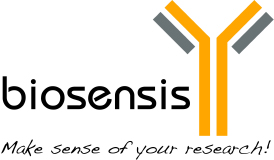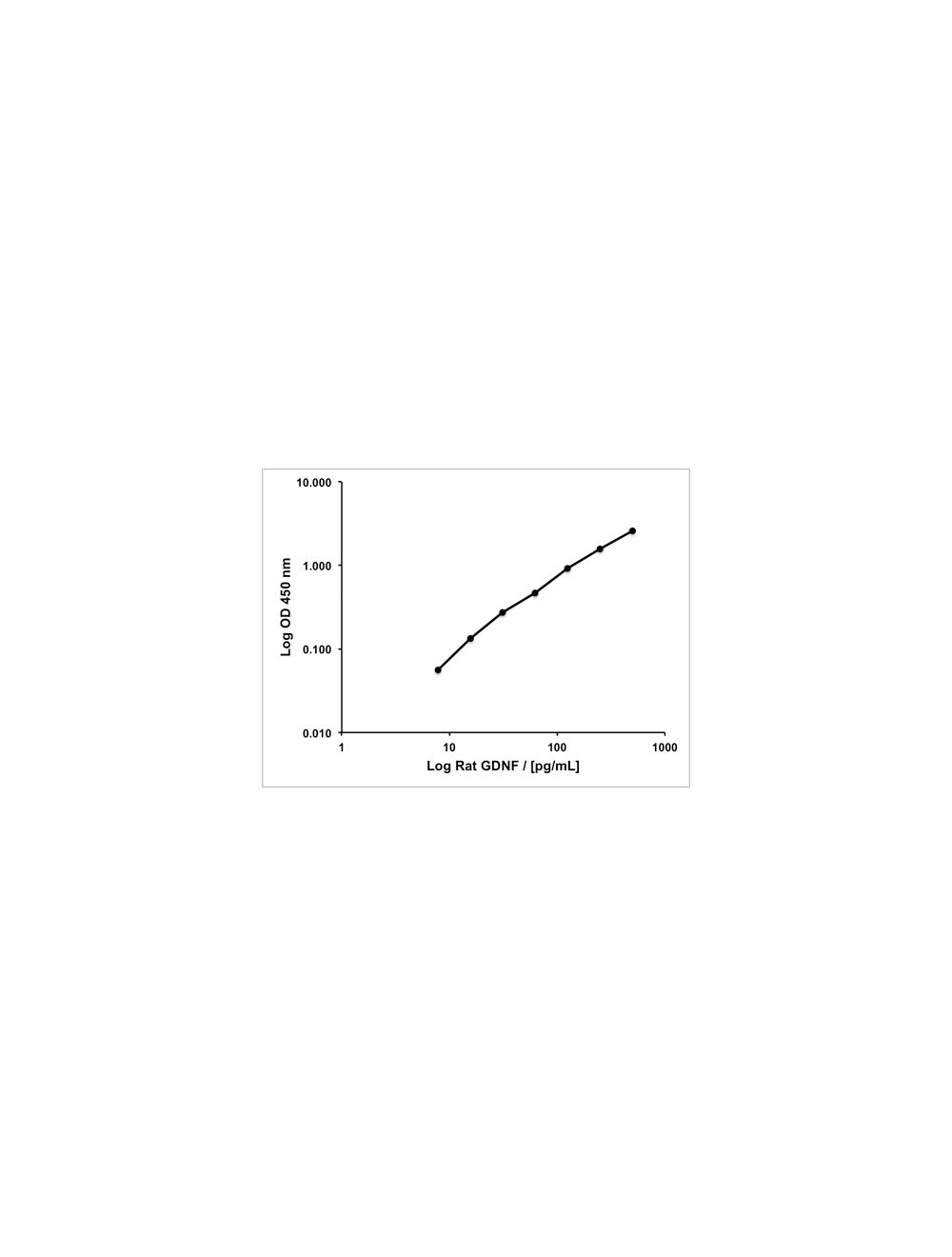Glial cell line-derived neurotrophic factor (GDNF), Rat, Rapid™ ELISA assay
- Product Name Glial cell line-derived neurotrophic factor (GDNF), Rat, Rapid™ ELISA assay
-
Product Description
The Biosensis GDNF RapidTM enzyme-linked immunosorbent assay (ELISA) Kit is a sandwich ELISA that allows the quantification of GDNF in less than 4 hours in cell culture supernatants, cell lysates, and serum only if used as directed. Please refer to the kit protocol for specific use instructions for each substrate application, in particular rat serum samples.
This ELISA kit consists of a pre-coated anti-GDNF capture antibody, a biotinylated anti-GDNF detection antibody and horseradish peroxidase (HRP)-conjugated streptavidin. The addition of a substrate (3,3',5,5'-tetramethylbenzidine, TMB) yields a colored reaction product which is directly proportional to the concentration of GDNF present in samples and protein standards.
This GDNF ELISA kit employs a recombinant rat GDNF standard and is therefore designed to measure the rat form of GDNF. Note that the antibodies used in this kit cross-react with mouse, human and guinea pig GDNF.
This kit has not been tested for other applications. It has been configured for research use only and is not to be used in diagnostic or clinical procedures. - Alternative Names Glial cell line-derived neurotrophic factor; Astrocyte-derived trophic factor; ATF; GDNF;
- Application(s) ELISA
-
Specificity
Rat. The antibodies used in this kit detect human and mouse GDNF.
The assay antibodies cross-react with guinea pig GDNF as evidenced by measuring GDNF in guinea pig serum with the Human GDNF RapidTM ELISA kit . All Biosensis GDNF RapidTM ELISA kits use the same capture and detection antibodies, and thus this Rat GDNF RapidTM ELISA kit can be used to assay guinea pig GDNF in serum. However, in absence of a true guinea pig GDNF protein standard, the Human GDNF RapidTM ELISA kit may give the most accurate estimations of guinea pig GDNF levels based on amino acid sequence homology. No cross-reactivity was observed for the following proteins tested at 25 ng/mL in assay buffer: brain-derived neurotrophic factor (rhBDNF), nerve growth factor (rhNGF), neurotrophin-3 (rhNT-3), rhNT-4/5, vascular endothelial growth factor (rhVEGF), recombinant human Neurturin, Artemin and Persephin. - Species Reactivity Rat
- Immunogen Description Recombinant rat GDNF protein, made in E.coli
- Range 7.8 - 500 pg/mL
- Sensitivity Typical limit of detection (LOD) for rrGDNF is <5 pg/mL determined as blank value plus 3x standard deviation of blank OD (n=10).
- Regulatory Status For research use only.
Product Info
-
Product Description
The Biosensis GDNF RapidTM enzyme-linked immunosorbent assay (ELISA) Kit is a sandwich ELISA that allows the quantification of GDNF in less than 4 hours in cell culture supernatants, cell lysates, and serum only if used as directed. Please refer to the kit protocol for specific use instructions for each substrate application, in particular rat serum samples.
This ELISA kit consists of a pre-coated anti-GDNF capture antibody, a biotinylated anti-GDNF detection antibody and horseradish peroxidase (HRP)-conjugated streptavidin. The addition of a substrate (3,3',5,5'-tetramethylbenzidine, TMB) yields a colored reaction product which is directly proportional to the concentration of GDNF present in samples and protein standards.
This GDNF ELISA kit employs a recombinant rat GDNF standard and is therefore designed to measure the rat form of GDNF. Note that the antibodies used in this kit cross-react with mouse, human and guinea pig GDNF.
This kit has not been tested for other applications. It has been configured for research use only and is not to be used in diagnostic or clinical procedures. -
Related Products
Glial cell line-derived neurotrophic factor (GDNF), Human, Rapid™ ELISA assay
Glial cell line-derived neurotrophic factor (GDNF), Mouse, Rapid™ ELISA assay
- Application(s) ELISA
- Application Details ELISA. For the quantification of Glial cell line-derived neurotrophic factor (GDNF) in Culture Supernatant, Cell Lysates, Serum. Please download the detailed product insert for complete instructions for the successful use of this ELISA. Use only as directed.
- Target Glial cell line-derived neurotrophic factor (GDNF)
-
Specificity
Rat. The antibodies used in this kit detect human and mouse GDNF.
The assay antibodies cross-react with guinea pig GDNF as evidenced by measuring GDNF in guinea pig serum with the Human GDNF RapidTM ELISA kit . All Biosensis GDNF RapidTM ELISA kits use the same capture and detection antibodies, and thus this Rat GDNF RapidTM ELISA kit can be used to assay guinea pig GDNF in serum. However, in absence of a true guinea pig GDNF protein standard, the Human GDNF RapidTM ELISA kit may give the most accurate estimations of guinea pig GDNF levels based on amino acid sequence homology. No cross-reactivity was observed for the following proteins tested at 25 ng/mL in assay buffer: brain-derived neurotrophic factor (rhBDNF), nerve growth factor (rhNGF), neurotrophin-3 (rhNT-3), rhNT-4/5, vascular endothelial growth factor (rhVEGF), recombinant human Neurturin, Artemin and Persephin. - Target Cross-Reactivity (ELISA) No cross-reactivity was observed for the following proteins tested at 25 ng/mL in assay buffer: brain-derived neurotrophic factor (rhBDNF), nerve growth factor (rhNGF), neurotrophin-3 (rhNT-3), rhNT-4/5, vascular endothelial growth factor (rhVEGF), recombinant Human Neurturin, Artemin and Persephin.
- Target Host Species Rat
- Species Reactivity Rat
- Immunogen Description Recombinant rat GDNF protein, made in E.coli
- Range 7.8 - 500 pg/mL
- Sensitivity Typical limit of detection (LOD) for rrGDNF is <5 pg/mL determined as blank value plus 3x standard deviation of blank OD (n=10).
- Sample Type Cell Lysates, Culture Supernatant, Serum
- Detection Method Colorimetric
- Kit Components The ELISA kit box contains 96-well pre-coated strip plate(s), protein standards, detection reagents, wash and sample buffers, substrate buffer and detailed protocols.
- Storage Instructions Store at 2-8°C.
- Storage Temperature 2-8°C
- Batch Number Please see item label.
- Expiration Date 12 months from purchase.
- Alternative Names Glial cell line-derived neurotrophic factor; Astrocyte-derived trophic factor; ATF; GDNF;
- Uniprot Number Q07731
- Uniprot Number/Name Q07731 (GDNF_RAT)
- Scientific Background GDNF is a glycosylated, disulfide-bonded homodimer molecule. It was first discovered as a potent survival factor for midbrain dopaminergic neurons and was then shown to rescue these neurons in animal models of Parkinson's disease. GDNF is about 100 times more efficient survival factor for spinal motor neurons than the neurotrophins. FUNCTION: Neurotrophic factor that enhances survival and morphological differentiation of dopaminergic neurons and increases their high-affinity dopamine uptake. SUBUNIT: Homodimer; disulfide-linked. SUBCELLULAR LOCATION: Secreted protein. ALTERNATIVE PRODUCTS: 2 named isoforms produced by alternative splicing. DISEASE: Defects in GDNF may be a cause of Hirschsprung disease (HSCR). In association with mutations of RET gene, defects in GDNF may be involved in Hirschsprung disease. This genetic disorder of neural crest development is characterized by the absence of intramural ganglion cells in the hindgut, often resulting in intestinal obstruction. DISEASE: Defects in GDNF are a cause of congenital central hypoventilation syndrome (CCHS); also known as congenital failure of autonomic control or Ondine curse. CCHS is a rare disorder characterized by abnormal control of respiration in the absence of neuromuscular or lung disease, or an identifiable brain stem lesion. A deficiency in autonomic control of respiration results in inadequate or negligible ventilatory and arousal responses to hypercapnia and hypoxemia. SIMILARITY: Belongs to the TGF-beta family. GDNF subfamily.
- Shipping Statement For order quantities larger than 1 plate, this product is supplied in package units of 2 plates.
- Shipping Temperature 2-8°C (on cold packs)
- UNSPSC CODE 41116158
- Regulatory Status For research use only.
Specifications
-
Specific References
Su X et al. (2023) Decellularized extracellular matrix scaffold seeded with adipose-derived stem cells promotes neurorestoration and functional recovery after spinal cord injury through Wnt/ β-catenin signaling pathway regulation Biomed Mater. 19(1). Application: Rat, Tissue homogenate; Cell culture supernatant.
Székiová E et al. (2023) Characterisation of mesenchymal stem cells conditioned media obtained at different conditioning times: their effect on glial cells in in vitro scratch model Growth Factors. [Epub ahead of print] Application: Cell culture supernatant.
Ying X et al. (2022) Glial cell-derived neurotrophic factor decrease may medicate learning, memory and behaviour impairments in rats after neonatal surgery Brain Res Bull.178:9-16. Application: Rat, Urine
Possamai-Della T et al. (2022) Imipramine Can Be Effective on Depressive-Like Behaviors, but Not on Neurotrophic Factor Levels in an Animal Model for Bipolar Disorder Induced by Ouabain Mol Neurobiol. [Epub ahead of print] Application: Rat, brain tissue homogenate.
Castro SL et al. (2022) Blueberry Juice Augments Exercise-Induced Neuroprotection in a Parkinson’s Disease Model Through Modulation of GDNF Levels. IBRO Neurosci Rep. [Epub ahead of print] Application: Rat, brain tissue homogenate.

 1800 605-5127
1800 605-5127 +61 (0)8 8352 7711
+61 (0)8 8352 7711

